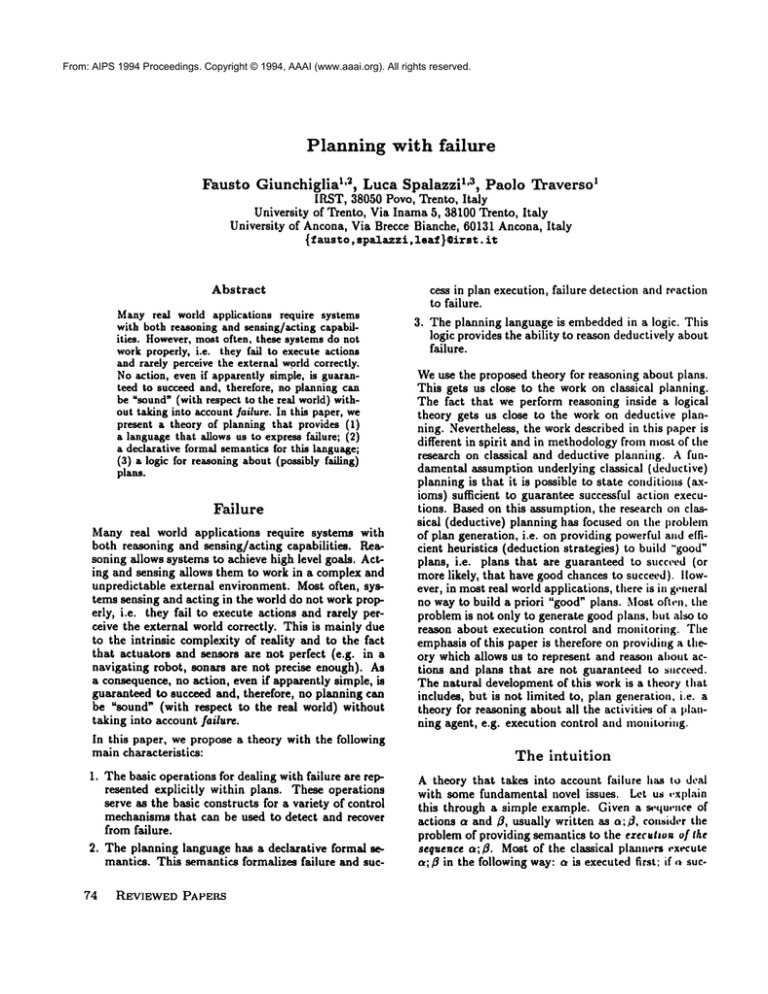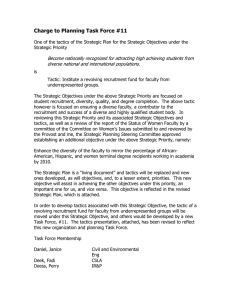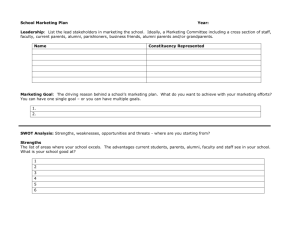
From: AIPS 1994 Proceedings. Copyright © 1994, AAAI (www.aaai.org). All rights reserved.
Planning with failure
1’2, Luca Spalazzi 1,3, lPaolo Traverso
IRST, 38050 Povo, Trento, Italy
University of Trento, Via Inama 5, 38100 Trento, Italy
University of Ancona, Via Brecce Blanche, 60131 Ancona, Italy
{ fausto,
spalazzi,
leaf}@irst.
it
Fausto
Giunchiglia
Abstract
Manyreal world applications require systems
with both reasoning and sensing/acting capabilities.
However,most often, these systems do not
workproperly, i.e. they fall to execute actions
and rarely perceive the external worldcorrectly.
Noaction, even if apparently simple, is guaranteed to succeed and, therefore, no planning can
be ~sound"(with respect to the real world) without taking into accountfailure. In this paper, we
present a theory of planning that provides (1)
a languagethat allows us to express failure; (2)
a declarative formal semanticsfor this language;
(3) a logic for reasoningabout (possibly failing)
plans.
Failure
Many real world applications require systems with
both reasoning and sensing/acting capabilities. Reasoning allows systems to achieve high level goals. Acting and sensing allows them to work in a complex and
unpredictable external environment. Most often, systems sensing and acting in the world do not work properly, i.e. they fail to execute actions and rarely perceive the external world correctly. This is mainly due
to the intrinsic complexity of reality and to the fact
that actuators and sensors are not perfect (e.g. in
navigating robot, sonars are not precise enough). As
a consequence, no action, even if apparently simple, is
guaranteed to succeed and, therefore, no planning can
be "sound" (with respect to the real world) without
taking into account failure.
In this paper, we propose a theory with the following
main characteristics:
1. The basic operations for dealing with failure are represented explicitly within plans. These operations
serve as the basic constructs for a variety of control
mechanisms that can be used to detect and recover
from failure.
2. The planning language has a declarative formal semantics. This semantics formalizes failure and suc74
REVIEWED PAPERS
cess in plan execution, failure detection and reaction
to failure.
3. The planning language is embeddedin a logic. This
logic provides the ability to reason deductively about
failure.
Weuse the proposed theory for reasoning about plans.
This gets us close to the work on classical planning.
The fact that we perform reasoning inside a logical
theory gets us close to the work on deductive planning. Nevertheless, the work described in this paper is
different in spirit and in methodologyfrom most of the
research on classical and deductive pla,miag. A fundamental assumption underlying classical (ded.ctive)
planning is that it is possible to state co,lditio.s (axioms) sufficient to guarantee successful action executions. Based on this assumption, the research on classical (deductive) planning has focused o,i the proble,n
of plan generation, i.e. on providi.g powerfula,Ld efficient heuristics (deduction strategies) to build "good"
plans, i.e. plans that are guaranteed to succeed (or
more likely, that have good chances to succeed). I[owever, in most real worldapplications, there is in ge.eral
no way to build a priori "good" plans. Mostofte,i, the
problemis not only to generate good plans, but also to
reason about execution control and monitoring. The
emphasisof this paper is therefore on providi.g a tlleory which allows us to represent and reaso, about actions and plans that are not guaranteed to s.cc(~ed.
The natural development of this work is a theory that
includes, but is not limited to, plan geaeratio,i, i.e. a
theory for reasoning about all the activities of a i,la.ning agent, e.g. execution control and mo.itori.g.
The intuition
A theory that takes into account failure has to deal
with some fundamental novel issues. Let us ,.xplain
this through a simple example. Given a s,.que,tce of
actions a and ~, usually written as o:~. co.sider the
problem of providing semantics to the erecalios of the
sequence a; ~. Most of the classical pin,reefs execute
a;~ in the following way: a is executed first: if ,~ suc-
From: AIPS 1994 Proceedings. Copyright © 1994, AAAI (www.aaai.org). All rights reserved.
ceeds,
theyexecute
8 afterwards;
ifa fails,
theydonot
execute
8 andrecover
fromfailure,
e.g.by replanning.
Consider
now,as an example,
the DynamicLogicsemantics
of a;8,i.e.p(a;8),
wherep is therelation
describing
accessibility
between
pairsofstates
(Harel
1984).
p(a;8) isdefined
asp(a)-P(8),
i.e.the
catenation
of p(a)andp(8),whena succeeds
as
as whena falls.Butwhena fails,a, andonlya, not
8, getsexecuted
and changestheworld.Therefore,
p(a;8)doesnottakeintoaccount
failure.
Theideais to provide
a semantics
thattakesintoaccountfailure.
Forinstance,
letthen(a,
8) denote
the
execution
of a sequence
of actions
(weusethe symbolthento distinguish
it fromtheusualsymbolfor
sequences,
i.e.;).Intuitively,
we builda semantics
whereS(a)[F(a)]denotesthefactthata succeeds
[fails].
We havethat
S(then(a,8)) = S(a). S(8)
F(then(a,8)) = F(a) U S(a).
(1) states that the execution of the sequence succeeds
(S(then(a,8))) iff both the actions succeed ($(a)
S(8)). (2) states that the execution of the sequence
fails iff either the first action fails (F(a)) and the
ond is not executed or the first succeeds and the second
falls (S(a) ¯ F(8)). This topic is described in detail
Section "A planning language with failure".
Consider now the DynamicLogic axiom used to reason
about sequences, i.e. [a; 8]P *’* [a](D~]p), where p is
wff representing the properties holding after the execution of a; 8. This axiomdoes not distinguish explicitly
the case where a falls. Webuild a logical theory where
the wff T(a, "if’) [T(c~, "F")] means intuitively
a succeeds [falls]. In general, T(a, Up,) stands for "the
proposition p holds after executing a ~. This theory
allows for reasoning about failure, i.e. for reasoning
about the state of the world after that failure occurs.
For instance, we can prove the following theorem
T(a, "F") A T(a, "p") D T(then(a, 8), (3)
which states that, if p holds after that a fails, then
p holds after executing the sequence then(a;8). This
topic is described in detail in Section ~Reasoningabout
failure".
A planning
language
with
failure
The syntax
In MRG,plans are expressions called tactics. The syntax
of tactics is based upona set of symbolsTo, that we call
primitive tactics 1. Intuitively, this set represents basic
1 Moreprecisely, primitive tactics ~e constructed from
a set of usual first order terms and a set of tactic agmboim,
actions. For instance, goto(A) can be a basic (even if
very complex)action which movesa robot in a location
(position) A, e.g. by means of an in-door navigation
system. From To, we inductively construct the set of
tactics 7". For lack of space we do not describe the full
syntax of MRG.Wefocus on the subset of the language
that deals with failure.
1. EET,~ET,
TOC_T
2. if a, 8, 7 E T, then iffaU a then ~ else 7 E T,
E and @represent the basic actions that generate success and failure, respectively. E [@] does nothing
else but terminate execution in s state of success [failure]. The intended meaning of iffall a then 8 else 7
is: "do a, if a fails do 8, otherwise do 7"- The full
syntax of MRG
allows for tactics that include conditional
expressions of the form if P then a else 8, loops of the
form while P do cr and recursive definitions. Moreover, it allows us to represent explicitly the internal
planningactivities of the planner itself, like plan generation, plan execution and information acquisition (see
(Traverso, Cimatti, & Spalazzi 1992)). Finally, it
lows expressions representing goals to be achieved (e.g.
At(A), which corresponds to the goal satisfied when
the robot is at the location A in a building). The
full syntax of the l~ltG planning language is given in
(Traverso & Spalazzi 1993)
A remark. The tactics E and ¯ allow the planner to
state explicitly whether a tactic fails or succeeds. Success and failure of a tactic does not coincide necessarily with the achievement/not-achievement of a related
goal. The former is a property of tactics, the latter
is a relation between tactics and goals. A tactic may
fail and, nevertheless, achieve the goal the tactic has
been executed for. For instance, the tactic goto(A)
that movesa robot to a given location A, can be executed to achieve the goal At(A’), i.e. the world state
where the robot is in an area A~ that contains A. The
tactic, when executed, may fail when the robot is in
A~ but not in A. It therefore achieves the goal. Vice
versa, a tactic may succeed and may not achieve the
goal, e.g. in the case the tactic goto(A’) is executed
to achieve the goal At(A). This is a possible situation
in systems where the actuators and sensors may not
allow for executing tactics precise enough to guarantee
the achievement of certain goals, e.g. a precise robot
position. Other tactics can thereafter be executed to
try to decide whether the goal has been achieved.
Weextend the language with the following definitions
which express someof the constructs that cast be used
to control failure:
1. then(a, 8) = |flail
a then ¯ else 8,
that, intuitively represent action types. Forlack of spacewe
skip the formaldefinition of the synt&xof primitive tactics.
GIUNCHIGLIA
75
From: AIPS 1994 Proceedings. Copyright © 1994, AAAI (www.aaai.org). All rights
ofreserved.
states.
2. orelse(a, 8) --- iffail o then ~ else E,
3. ; (,~, 8) = iffall a then ~ else
4. repeat(a) orelse( th en( a, repeat(a)), E)
then captures the intended meaning of the execution
of a sequenceof actions that takes into account failure.
If the first action fails, it does not execute the second,
but simply terminates execution with failure, orelse
captures and reacts to failure: orelae(a, 8) reacts to
failure of a by executing/]. Since ~ can be an internal
planningactivity, e.g, plan generation or plan execution, oreIJe can represent recovery from failure by replanning (like in most classical planners, e.g (Wilkius
1985)) aa well as recovery from failure by executing special purpose exception handling routines (like in most
embedded planners, e.g. (Georgeff & Lansky 1986;
Simmons1990)). The construct ; resembles the sequential composition of Dynamic Logic. The second
action is executed anyway, independently of the failure/success of the first action, repeat is recursively
defined. It repeats the execution of a till a fails. If
a never fails, execution does not terminate. For instance, repeat(E) executes forever. Notice that if it
terminates, repeat(o) always succeeds, since orelse in
the definition of repeat reacts to failure by executing
E, which always succeeds. For instance, repeat(@) is
equivalent to orelse(¢~, E) which, &fter ~, executes
and succeeds.
As a simple example, consider a robot that tries to
movea block from the table. The robot does not manage to movethe block since it is steadily attached to
the table. Consider the problem of expressing this apparent failure with s success, since the robot is not
trying to movethe block on top of another block, but
is simply testing whether the block is safely attached
to the table. In MRG
this is captured by the following
tactic:
iffail
mo~e(block) then E else @
The construct iffail, together with the basic actions
for success and failure, allows us to express the fact
that if the action rno~e(block) succeeds, then we have
failure and vice versa.
s8 : 7~ --, 2
and
sY- : To -. 2
The success and failure set of E and 4~ are given below.
E always succeeds. Formally, this is captured by the
fact that its failure set is empty. E does nothing else
but succeeding. Formally, this means that its success
set is the set of behaviours composed by any single
state, i.e. ~,’. For instance, we have that, for any
tactic a, 8(a). 8(E) - 8(a). Vice versa, the success
set of ¯ is emptywhile its failure set is ~V.
The mappings 5 and ~" are extended inductively to
supply meaningsfor the full set of tactics 7". In the
following we extend the definition of ~q and ~ for the
subset of the languageof MltGdefined in this paper, i.e.
for the construct iffail. Wewrite bt. b2, wherebl, b2 E
8, as the concatenation of the two behaviours bt and
b2. This operation is extended to sets of behaviours in
the usual way.
,.q(iffail
a then ~ else 7) =
,S(a)
¯ 8(7).~’(,~) .’;(,~)
¯
~’(iffail
a then ~ else "y)
8(a). ~’(~)u 7"(a).~(~)
In the following we show the semantics of then and
orelse, which is derived according to their defiBdtions
in terms of iffail, E and q~.
8(then(.’.,/3)) = 0¯ 8(1 ])
.7"(then(a,,6)) -- ~"(a) U 8(or). 3c’(,3)
5( orelse(a, 8)) =8( a ) U.Tc’( ¯ 8( 3)
~’(orelse(a, ~)) = ~(~)..~(~3)
The semantics
The semantics of MP.Gis defined relative
structure//, of the form a
to a given
u = (w,8, s,.,*-)
where]IV is the usual set of states; B is a set, the elements of which are called beAaeiours, i.e. sequences
aActuslly, H contains also a domainset 2), but this is
not relev&nthere.
76
A tactic a is interpreted into a set of behaviours. This set is divided into two disjoint subsets:
the set 8(a) of successful behaviours, that we call the
success set of a, and the set .~’(~) of behaviours that
fail, that we call the failure set of a. 8 and ~ mapa
primitive tactic into a set of behaviours. Formally:
REVIEWEDPAPERS
repeat, which is recursively defined, is interprcted by
building a fix point.
Reasoning about failure
MT"is a first order classical metatheory which provides a deduction machinery for reasoning about MR6
tactics (and thus about failure). )tiT* has the following characteristics:
From: AIPS 1994 Proceedings. Copyright © 1994, AAAI (www.aaai.org). All rights reserved.
1. The language of MItG is ~embedded" in MT’. MItG
tactics becometerms of MT*. Intuitively, they denote the state of affairs after that a tactic has been
executed.
2. MT*allows wits of the kind T(a, "p"), where T is
predicate symbol, a is a tactic and "p" is a constant
denoting the wffp. Intuitively, the intended meaning
ofT(a, "f) is ~p holds after executing a".
3. MT*represents failure explicitly by means of a
proposition F. T(a, "F") IT(a, "-~F")] intuitively
means that the execution of a fails [succeeds].
Success is defined as the proposition S, where S *-*
-,F. Tactics in MT*are ground terms. The set of
tactics in MT*is constructed in the same way as the
set T in Mitt], where: To is a set of constants; E and
@are constants; iffall is a 3-place function symbol;
then, orelse, ; and repeat are defined function symbols
(e.g. YaY~then(a, ~) - iffall a then @else ~).
the following, we give some of the axioms of MT*.We
sometimeswrite a, ~ and 7 either as variables of sort
tactic or as tactics (i.e. groundterms). The distinction
should be clear from the context.
The fol]owing axioms state that after executing an action, we have either failure or success. For any tactic
a we have:
(A1)
(8)
(A2)
The following axioms state the properties of E and (I).
For any proposition p, constant af of MT’, we have:
(A5) up" # "F" ^ ~p" # "S" D (T(E,"f) .--p)
(A6) "f # ~ A "f ’ # "5 ~’ D (T(~, "p ") ,- * p)
(9)
Axioms (A3) and (A4) state that E always succeeds
and ,I, always fails. Axioms(A5) and (A6) state
E and @ do not change the world but the fact that
they force success or failure.
The following axiomstates the properties of iffail. For
any tactic a, fl and 7, for any constant "f, we have:
((T(a, "if’) ^ T(a, "T(7, "p")"))V
(T(a, "F") ^ T(,~, "T(~, "p")")))
(TI) T(then(a,~), "p") *-*
((T(a, "S") A T(a, "T([3, "p")"))
(T(a,"F") A T(a,"p")))
(T2)
(10)
Axiom(AT) states that p holds aller executing iffall
iff it holds after executing a with success and 7 afterwards, or a with failure and ~ afterwards.
(11)
T(orelse(a, ~), "p")
((T(a, "S") A T(a, "p"))
(T(~, "F") ^ T(a, "T(~, "f’)")))
Theorem(T1) can be used to reason about the execution of sequences of actions that mayfail. In the right
hand of the equivalence we have two cases. If a succeeds (T(a, "S’)), then p holds after the execution
(T(a, "T(#, "p")’)). If a fails (T(a, "F")), p
ter the execution of a (T(a, "f)). Theorem(T2)
he used to reason about failure capturing and recovery
from failure.
From theorems (T1) and (T2) we can easily prove
following theorems. Notice the relation between these
theorems and the success and failure sets of then and
orelse reported in (7).
(T3)
T(then(a,~),"S")~--~
(T(a, "S’) A T(a, "T(,8, "S’)"))
(T4) T(then(a,/J),"F’)*-.,
(T(a, "F") V (r(a, "5") A T(er, "T(~,
(TS) T(orelse(a, ~), "S")
(T(,), "S") V (T(a, "F") A T(a, "T(~,
(T6) T(orelse(a,/3), "F") *-*
(T(a, "F") ^ T(a, "T(~, "F"
(Aa) "S’)
(A4) T(@,"F")
(AT) T(iffalla the,, ~ else 7, "p")
Fromthe axioms above and the definitions of then and
oreise we can prove the following theorems:
(12)
Someremarks. In classical planning, the behaviour of
basic actions can be described by axioms of the following form:
PlA ...Ap,D T(a,"q, A ...A qm")
These axiomsstate that, if the preconditions Pt .... , P,
hold, then the effects of the execution of a are
ql,...,qm.
But the actual effects of ~ depend on an
infinite number of preconditions, that no model of
the world can capture. The actual effects depend on
whether a will succeed or fail. In MT*,the fact that
failure is explicit can be used to give a more"realistic"
axiomatization that states that if ~ will not fail, then
somefacts will hold after its execution, e.g.:
T(a,"-,F")Ap,
A ...Ap,D T(¢~,"q,A ...A q,/’)(13)
Wecan define failure (and similarly success) for a primitive tactic a with axioms of the form
GIUNCHIGLIA 77
From: AIPS 1994 Proceedings. Copyright © 1994, AAAI (www.aaai.org). All rightsassumption
reserved. is
T(a,"F")*-*T(a,"r1")A ...A T(a,"re")(14)
i.e. the planner decides that an action fails whenthe
conditions el ..... rk are observed from the world after
that a has been executed. Notice the difference between axioms (14) and axioms of the form
rl A ... A r~ D T(a, "F")
(15)
In (15), any el is a condition over the world before that
gets executed. In (14), any T(a, "I"/") is a condition
after the execution of ~,. In (15), failure is predicted.
Axioms (14) can instead be used when failure cannot
be predicted. As a simple example, we can define failure and success of navigation in an environment where
it is impossible to predict the presence of unavoidable
obstacles as follows:
T(goto(A), "-,F’) ,-. T(goto(A), "At(A)")
T(goto(a),
"F’) ~ T(eoto(A), "-,At(A)")
where At(A) means that the robot is at A.
Finally, in MT"we can assume that an action succeeds (or fails) and deduce consequences depending
on that assumption. That is, we can hypothetically
reason about failure without knowing whether the action will actually fail or succeed. For instance, we can
assume T(a, "-,F") and derive all the possible interesting consequences that hold whenever a succeeds,
e.g. T(a, "p’). Wecan assume that either a does not
fail or failure of a is recovered by ~ afterwards, i.e.
T(orelse(a, B), "-,F"), and derive that, under that hypothesis,
T(a, "f) V T((~, "T(~, "q")")
where q is a property that holds after that a falls and
succeeds.
Related
work
As far as we know, the approach presented in this paper has never been proposed before. So far, failure has
had very little attention in formal theories of actions.
This is the case of DynamicLogic (Hard 1984), as
discussed in Section "The intuition", and, as a consequence, of the approaches to planning based on Dynamic Logic, e.g. (Rosenschein 1981). This is also the
case of the workdescribed in (Steel 1993), which shares
with our research most of the underlying motivations.
The idea that actions in the real world may fail is,
of course, present in most of the work on reasoning
about actions and plans. But none of them provides
a theory where failure is represented explicitly in the
language, in the semantics and in the logic. The usual
78
I~EVIEWED PAPERS
that it is possible to assert axiomsthat
define the conditions sufficient to guarantee successful
action attempts (see for instance (Allen & Ferguson
Lifschitz 1993)). This assumption is not realistic for
the real world applications we are interested in.
A lot of recent research in planning is more and more
focusing on real world applications where failure is a
key aspect. This is the case of the research on "embedded planners". Several embedded planners have
been proposed so far (see for instance (Georgeff &Lansky 1986; Simmons 1990; Beetz & McDermott 1992;
Firby 1992; Spalazzi, Cimatti, & Traverso 1992b))
and have been successfully applied in particular application domains (like mobile robots (Georgeff, Lansky, & Schoppers 1986; Simmons 1991; Cimatti et
al. 1992) and fault diagnosis for real time systems
(Georgeff & Lansky 1986)). Most of them provide different and flexible failure handling mechanisms, see
for instance (Georgeff, Lansky, & Schoppers 1986;
Simmons1990). Nevertheless, so far this research has
focused on domain specific applications and on system
architectures. As a consequence, the current work is
far for providing a general theoretical frameworkfor
representing and reasoning about failure. A partial
exception is the work described in (Georgeff & Lansky 1986), where the semantics of PRS processes is
constructed via a failure and a success set. A difference between MRGand PRSis that in MR0,failure and
success are represented explicitly in the planning language. Wehave circumscribed the set of basic operations and constructs that deal with failure (i.e. iffail,
E and 40. Given these building blocks, it is possible to
give a clear semantics to MRG
expressions equivalent to
PRSprocesses. Moreover, we have provided a logical
theory (MT’) to reason deductively about I(RG plans,
while PIgS does not allow this.
Conclusions
and
future
work
Wehave described a language for planning, called MR(;,
where failure and success are represented explicitly.
This language allows control constructs that capture
and react to failure. This opens up the possibility
of building plans that recover from failure in different ways depending on different situations, e.g. either
by replanning (as in classical planners) or by executing exception handling routines (as in embeddedplanners). This planning language has a declarative .~mlantics that provides a formal explanation to failure and
success and that can be used to describe actual executions within the real world. Finally, we have described
a logical metatheorywhere it is possible to reason (hypothetically) about failure and success.
At the moment,I(RG is the planning language used in
large scale, real world application under development
at IB.ST (Strings 1991; Spalazzi, Cimatti, & Traverso
1992b). This application aims at the develop,,~e,lt of
From: AIPS 1994 Proceedings. Copyright © 1994, AAAI (www.aaai.org). All rights reserved.
a system that has to control and coordinate mobile
robots, navigating in unpredictable enviroments inhabited by humans and performing high level tasks, like
transportation tasks in hospitals and offices (Stringa
1991; FIRST 1993). KEGplans are executed by means
of systems that act in the real world, e.g. a reactive
sensor and actuator controller for navigation tasks and
a system for speech recognition.
Major future goals include extensions to MT*to reason about the whole set of altO; plans, in particular
the plans that contain representations of the internat activities of the planner itself, e.g. plan generation, plan execution and information acquisition
(Traverso, Cimatti, & Spalazzi 1992). Wealso intend to develop a complete formal account of the
relations
between KRGand MT*. The idea is to
extend the results proved for a logical metatheory
for theorem proving (Giunchiglia & Traverso 1991;
1994) which is expressive enough to represent theorem
proving strategies and failure.
Acknowledgments
This work has been conducted as part of MAIA,the
integrated AI project under development at IRST. A
preliminary version of the work described in this paper has been presented and discussed at the Dagstuhl
seminar on "Deductive Approaches to Plan Generation
and Plan Recognition", 1993. Wethank the members
of the Mechanized Reasoning Groups in Ttento and
Genoa. Wealso thank Michael Georgeff and SamSteel
for fruitful discussions about this work.
References
Allen, J., and Ferguson, G. Actions and Event~ in
Interval Temporal Logic. Submitted to J. Logic and
Computation, Special Issue on Action and Processes.
Beetz, M., and McDermott, D. 1992. Declarative
Goals in Reactive Plans. In Hendler, J., ed., Artificial Intelligence Planning Systems: Prac. of 1st Inter.
national Conference, 3-I2. San Marco, CA: Morgan
Kaufmann.
Cimatti, A.; Traverso, P.; Dalbosco, S.; and Armando, A. 1992. Navigation by Combining Reactivity and Planning. In Prac. Intelligent Vehicles ’gg.
IRST-Technical Report 9205-11, IRST, Trento, Italy.
Firby, R. J. 1992. Building Symbolic Primitives with
Continuous Control Routines. In Handler, J., ed., Artificial Intelligence PlanningSystems: Prec. of 1st International Conference, 62-69. San Marco, CA: Morgan Kanfmann.
FIRST. 1993. Friendly Interactive Robot for Service
Tasks. EUREKAEU474 PROJECT.
Georgeff, M., and Lansky, A. L. 1986. Procedural
knowledge. Prec. of IEEE 74(10):1383-1398.
Georgeff, M.; Lansky, A.; and Schoppers, M. 1986.
Reasoning and planning in dynamic domains: An experiment with a mobile robot. Technical Report 380,
A.I. Center, SRI International.
Giunchiglia, F., and Traverso, P. 1991. Reflective
reasoning with and between a declarative metatheory
and the implementation code. In Proc. o/the l~th
International Joint Conference on Artificial Intelligence, 111-117. Also IRST-Technical Report 9012-03,
IILST, Trento, Italy.
Giunchiglia, F., and Traverso, P. 1994. Program
Tactics and Logic Tactics. In Proceedings 5th Intnl.
Conference on Logic Programming and Automated
Reasoning (LPAR’g~). Also IRsT-Technical Report
9301-01, IRST, Trento, Italy. Presented at the Third
International Symposiumon Artificial Intelligence
and Mathematics, Fort Lauderdale, Florida, January
1994.
Hard, D. 1984. Dynamic Logic. In Gabbay, D., and
Guenthner, F., ads., Handbooko/Philosophical Logic,
volume II. D. Reidel Publishing Company.497-604.
Lifschitz, V. 1993. A Language for Describing Actions. In Proceedings Second Symposium on Logical
Formalizations of CommonsenseReasoning.
Rosenschein, S. 1981. Plan synthesis: A logical perspective. In Proc. of the 7th International Joint Conference on Artificial Intelligence, 331-337.
Simmons, R. 1990. An Architecture for Coordinating Planning, Sensing and Action. In Procee&agsof
the Workshop on Innovative Approaches to Planning,
Scheduling and Control, 292-297.
Simmons, R. 1991. Coordinating planning, perception and action for mobile robots. In AAAI Spring
Symposiumon Integrated Intelligent Arch,lectures,
156-159. SIGART
Bulletin vol. 2 no. 4.
Spalazzi, L.; Cimatti, A.; and Traverso, P. 1992. Implementing planning as tactical reasoning. In Prec.
AIS’gg, AI Simulation and Planning in High Autonomy Systems Conference, 80-85. Perth Australia:
IEEE Computer Society Press.
Steel, S. 1993. Actions on Beliefs. To appear in:
Journal of Applied Non-Classical Logics.
Stringa, L. 1991. An Integrated Approachto Artificial
Intelligence:
the MAIAProject at IRST. Technical
Report 9103-13, IRST, Trento, Italy.
Traverso, P., and Spalazzi, L. 1993. Towardsa riteory of embeddedplanning. Technical Report 9308-0 I.
IRST, Trento, Italy.
Traverso, P.; Cimatti, A.; and Spalazzi, L. 1992.
Beyondthe single planning paradigm: introspective
planning. In Proceedings ECAI-9~, 643-647. litSTTechnical Report 9204-05, IRST, Trento. Italy.
Wilkins, D. 1985. Recovering from execution errors
in SIPE. Computational Intelligence 1:33-45.
GIUNCHIGLIA 79





